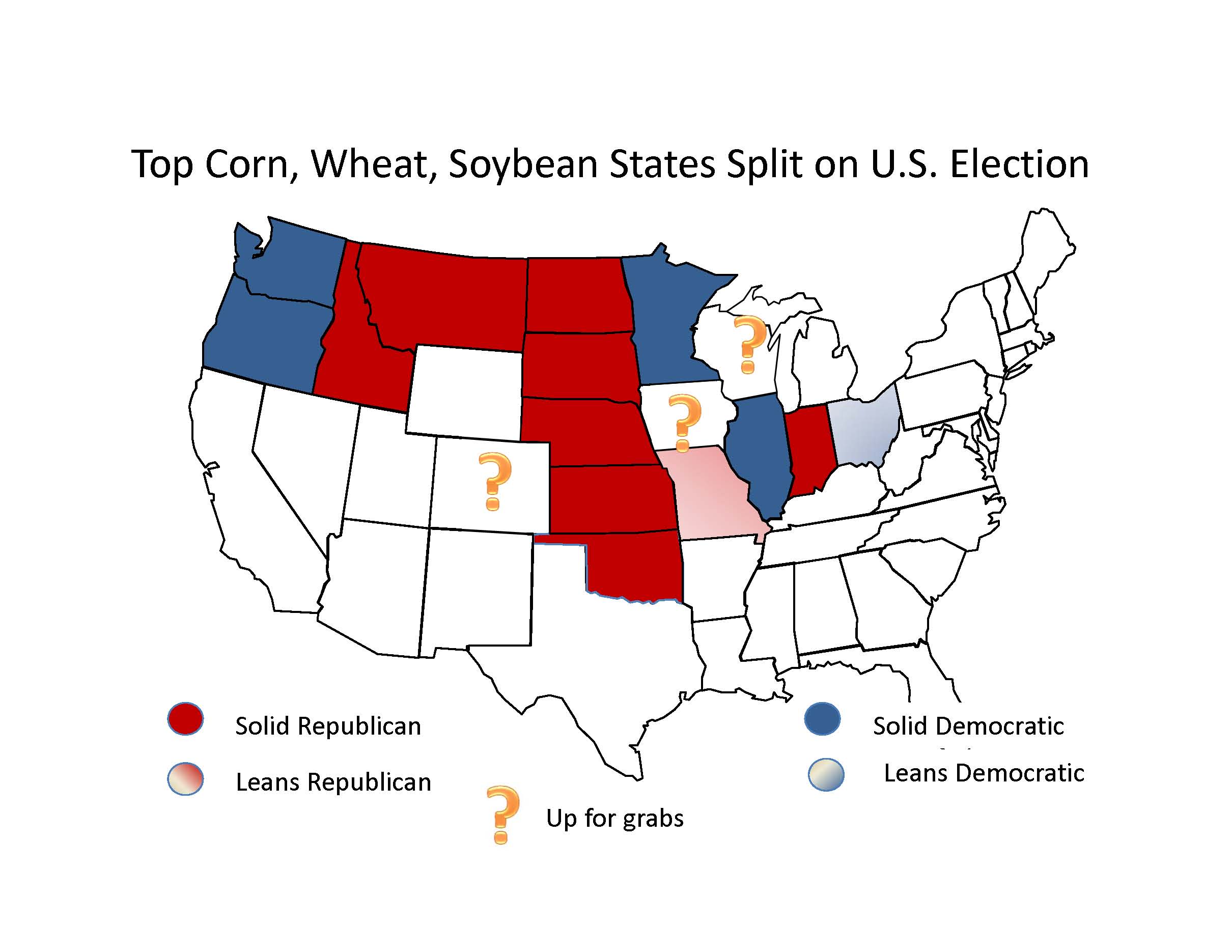Agriculture and the US election
.
There’s a legend that Walter Goeppinger, who founded the National Corn Growers Association (NCGA), turned down the chance to be John Kennedy’s secretary of agriculture because Goeppinger wanted to maintain his influence with both Democrats and Republicans.
Whether that’s true or not, good bipartisan relations are key to passing farm legislation, and US corn, soybean and wheat associations make a point of working with both parties.
PHOTO SHOWING the top 10 wheat, top 10 corn, and top 10 soybean states and how they lean on the US presidential election as of Oct. 12. State political analysis is from TheFix (published in the Washington Post). The solid Democrat + lean Democrat states add up to 67 electoral votes. The solid Republican/lean Republican states total 52 electoral votes. The three undecided states total 25 votes.

Though all three have political action committees, they are carefully bipartisan. None endorse a presidential candidate, and two of the three do not produce a “key issues list” for rating presidential candidates. “There are so many issues cutting so many ways that we leave the decisions up to our members,” says one association executive.
The NCGA is the exception, surveying candidates on ten issues in the run-up to the Iowa caucuses and issuing a report card to its members.
Both Barack Obama and Mitt Romney earned a “B” in the 2012 survey, which also factors in statements in the media and internet research; but they reached the same score in very different ways.
The only complete agreement was on support for free trade, where both earned an “A.” Romney outscored Obama on general ethanol and energy policy and on EPA regulations and oversight, while Obama beat Romney on the Renewable Fuels Standard, ethanol infrastructure, the ACRE revenue program, and water infrastructure funds.
In practice, there are other issues that may weigh as heavily with farm voters as those on the NCGA list – for example, taxes.
In a newly released white paper, Romney promises to eliminate the federal estate tax permanently and taxes on savings for families earning less than $200,000 per year.
He also proposes significant changes to the US regulatory process, including requiring Congress to approve all new major regulations, establishing a cap that requires agencies to spend as much time repealing or streamlining old regulations as they spend advancing new ones, and freezing and reviewing all pending or proposed agricultural regulations to eliminate those that are ineffective or not economically justified.
In the energy sector, he promises to accelerate the development of US energy sources and pursue a North American Energy Partnership to allow the US to share in Canadian and Mexican energy resources.
As an incumbent, Obama can go beyond what he would do, and claim credit for what he has done. That includes an expansion of farm credit during the financial crisis and increases in emergency disaster assistance and crop insurance availability, but much of the USDA’s initiative under Obama has focused more on nutrition issues than farm programs.
Responding to a questionnaire from the American Farm Bureau Federation, he also claims to be, “the only candidate that is committed to strengthening the farm safety net, strengthening rural economic growth, and supporting rural investments in clean energy.”
Beyond the farm-specific issues, several other factors may play into American farmers’ voting choices.
Romney is focusing much of his campaign on Americans’ economic woes, which may not be as effective in energizing US farmers in a relatively positive farm economy.
Under the Obama administration, farmers have also benefited from extremely low loan rates.
Obama and USDA Secretary Tom Vilsack have attacked the Republicans aggressively on the failure to pass a farm bill. That is definitely a hot topic for growers – the wheat association has been especially active here – and it’s a very sore subject for livestock producers because a key disaster relief program that could help them with drought-related damages has not been renewed. Still, it’s hard to hold Romney accountable for the Republican-controlled House of Representatives.
Underlying all the issues of the moment, rural Americans are typically more conservative and more inclined to vote Republican than Democrat. The big question may be how much such a small share of the population – less than three million farmers and farm workers out of 315 million people – can affect the election outcome.
This year, the answer is that the farm vote could be quite important.
The eight swing states expected to decide the presidential race include three states – Iowa, Colorado, and Wisconsin – that rank among the top ten producers of wheat, soybeans, or corn. Two other big grain-producing states are also in play, according to recent polls: Missouri, which leans toward Romney, and Ohio, which leans Obama.
Within each of these states, the election could be decided by a few thousand, maybe even a few hundred votes. Colorado has 36,700 farms and ranches; Iowa has 92,600; Wisconsin has 78,000. That’s not a precise measure of the farm vote, but clearly the difference between a weak or strong showing in farm country could decide a state’s winner.
It’s no surprise that both campaigns are working madly not only to win support but to maximize the turnout of their voters and that modest communities like Van Meter, Iowa (population 1,067), find presidential candidates coming to town to roll out their agricultural positions. •
| Issue | Obama | Romney |
| Ethanol & Energy Policy Generally | B | A |
| Renewable Fuels Standard | A | B |
| Ethanol Infrastructure | A | B |
| Federal Crop Insurance | B | ? |
| ACRE (Revenue Program) | A | C |
| Conservation Programs | B | ? |
| Free Trade Agreements | A | A |
| Agricultural Trade Programs | B | ? |
| EPA Regulations/Oversight | C | B |
| Water Infrastructure Funds | B | C |
Adapted from NCGA’s Corn Caucus Project. A = Fully Supports. B = Leans in Support. C = Meets Minimal Criteria. For full details, go to http://www.iowacorn.org/en/policy/corn_caucus_project_overall_results/.






















